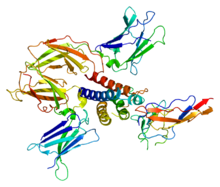| interleukin 15 receptor, alpha | |||||||
|---|---|---|---|---|---|---|---|
 | |||||||
| Identifiers | |||||||
| Symbol | IL15RA | ||||||
| NCBI gene | 3601 | ||||||
| HGNC | 5978 | ||||||
| OMIM | 601070 | ||||||
| RefSeq | NM_172200 | ||||||
| UniProt | Q13261 | ||||||
| Other data | |||||||
| Locus | Chr. 10 p15-10p14 | ||||||
| |||||||
| interleukin 2 receptor, beta | |||||||
|---|---|---|---|---|---|---|---|
 | |||||||
| Identifiers | |||||||
| Symbol | IL2RB | ||||||
| Alt. symbols | CD122 | ||||||
| NCBI gene | 3560 | ||||||
| HGNC | 6009 | ||||||
| OMIM | 146710 | ||||||
| RefSeq | NM_000878 | ||||||
| UniProt | P14784 | ||||||
| Other data | |||||||
| Locus | Chr. 22 q13 | ||||||
| |||||||
| interleukin 2 receptor, gamma (severe combined immunodeficiency) | |
|---|---|
 | |
| Identifiers | |
| Symbol | IL2RG |
| Alt. symbols | SCIDX1, IMD4 |
| NCBI gene | 3561 |
| HGNC | 6010 |
| OMIM | 308380 |
| RefSeq | NM_000206 |
| Other data | |
| Locus | Chr. X q13 |
Interleukin-15 receptor is a type I cytokine receptor, binding interleukin-15.[2]
Structure[edit]
The IL-15 receptor is comprised of the IL-2Rβ and γc subunits, along with a unique ligand-specific subunit, IL-15Rα, which bears homology to IL-2Rα. These receptor proteins feature protein-binding motifs known as "sushi domains." In both humans and mice, these receptors and their corresponding ligands are physically linked in the genome. Due to their shared receptor usage, IL-2 and IL-15 exhibit many similarities in their effects on lymphoid cells.[3]
Although the receptors for IL-2 and IL-15 share many structural analogies, two significant differences persist: Firstly, IL-15Rα has a broader expression compared to IL-2Rα, IL-2Rβ, and γc. It is found on lymphoid cells, dendritic cells (DCs), fibroblasts, epithelial cells, liver cells, intestinal cells and other cells and is thought to present IL-15 in trans to cells expressing IL-15β and γ chains. Secondly, IL-15Rα exhibits a remarkably high affinity for binding to IL-15, over 1000 times greater than the affinity of IL-2Rα binding to IL-2.[2][3]
Signaling[edit]
IL-15-mediated signaling in T lymphocytes leads to the activation of Janus kinase (JAK). JAKs play crucial signaling roles for several members of the cytokine receptor superfamily by activating signal transducer and activator of transcription (STAT) proteins. In lymphocytes, binding of IL-15 to the IL-2/15Rβγ heterodimer induces JAK1 activation that subsequently phosphorylates STAT3 via the β chain and JAK3/STAT5 activation via its γ chain.[4] Once tyrosine-phosphorylated, STAT transcription factors form homo- and/or heterodimers and migrate to the nucleus. There, they bind to target DNA regulatory elements and contribute to the activation of gene expression.[5]
IL-15 also trigger other signaling pathways, including the phosphorylation of cytoplasmic tyrosine kinases from the Src family such as Lck, Fyn, and Lyn, along with Syk kinase. They also activate phosphatidylinositol 3 kinase (PI3-kinase) and Akt, leading to the induction of the anti-apoptotic protein Bcl-2. Additionally, they stimulate the Ras/Raf/MEK/mitogen-activated protein kinase (MAPK) pathway.[5]
Function[edit]
The signaling pathway of the IL-15/IL-15R system is now understood to affect not only T-cell functions but also various other cell populations. Several recent reviews have extensively explored the functional significance of IL-15/IL-15R biology in T lymphocyte development and homeostasis, as well as in the development, maintenance, expansion, and activities of memory CD8+ T cells and NK cells.[5]
One of the most defining functional differences between IL-2 and IL-15 is that IL-15 is increasingly acknowledged as a significant modulator of various non-immune cell types, whereas the functions of IL-2 are predominantly restricted to T cells.[5]
References[edit]
- ^ PDB: 2B5IWang X, Rickert M, Garcia KC (November 2005). "Structure of the quaternary complex of interleukin-2 with its alpha, beta, and gammac receptors". Science. 310 (5751): 1159–63. Bibcode:2005Sci...310.1159W. doi:10.1126/science.1117893. PMID 16293754. S2CID 85394260.
{{cite journal}}: CS1 maint: date and year (link) - ^ a b Anderson DM, Kumaki S, Ahdieh M, Bertles J, Tometsko M, Loomis A, Giri J, Copeland NG, Gilbert DJ, Jenkins NA (1995). "Functional characterization of the human interleukin-15 receptor alpha chain and close linkage of IL15RA and IL2RA genes". J. Biol. Chem. 270 (50): 29862–9. doi:10.1074/jbc.270.50.29862. PMID 8530383.
- ^ a b O'Shea JJ, Gadina M, Siegel RM (2019), "Cytokines and Cytokine Receptors", Clinical Immunology, Elsevier, pp. 127–155.e1, doi:10.1016/b978-0-7020-6896-6.00009-0, ISBN 978-0-7020-6896-6, retrieved 2024-04-22
- ^ Mishra A, Sullivan L, Caligiuri MA (2014-04-15). "Molecular Pathways: Interleukin-15 Signaling in Health and in Cancer". Clinical Cancer Research. 20 (8): 2044–2050. doi:10.1158/1078-0432.CCR-12-3603. ISSN 1078-0432.
- ^ a b c d Budagian V, Bulanova E, Paus R, Bulfonepaus S (August 2006). "IL-15/IL-15 receptor biology: A guided tour through an expanding universe". Cytokine & Growth Factor Reviews. 17 (4): 259–280. doi:10.1016/j.cytogfr.2006.05.001.
External links[edit]
- Receptors,+Interleukin-15 at the U.S. National Library of Medicine Medical Subject Headings (MeSH)